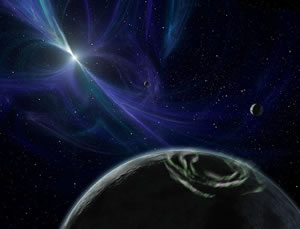
Ordinary computers like those folks use to send eMail or surf the internet are being credited with finding a previously unknown neutron star, highlighting the changing nature of research in the era of grid computing.
Home office computers in Ames, Iowa, and Mainz, Germany, were cited Aug. 12 in the discovery of fast-rotating pulsar called PSR J2007+2722.
It was the first scientific discovery for the project, known as Einstein@Home, which uses spare computer power donated by 250,000 volunteers in 192 countries, according to Bruce Allen, director of the effort.
“This is a thrilling moment for Einstein@Home and our volunteers. It proves that public participation can discover new things in our universe,” said Allen, who is director at the Max Planck Institute for Gravitational Physics in Germany and adjunct professor of physics at the University of Wisconsin-Milwaukee.
The finding of the new pulsar was reported in Science Express, the online version of the journal Science.
Data collected by the giant radio telescope at Arecibo Observatory in Puerto Rico are divided among the home computers of volunteers for analysis, and the results are fed back researchers based at Cornell University’s Center for Advanced Computing, the Albert Einstein Institute in Hannover, Germany, and the University of Wisconsin-Milwaukee.
James Cordes, a professor of astronomy at Cornell and chair of Pulsar ALFA Consortium, said that while the pulsar discovery is yet to be explored, its potential has drawn intense interest from the science community.
“No matter what else we find out about it, this pulsar is bound to be extremely interesting for understanding the basic physics of neutron stars and how they form,” Cordes said.
Einstein@Home is one of several scientific research projects using home computers that people make available. The research programs run in the background, using spare computing power that otherwise would go unused, in a technique known as grid computing.
The data sent to home computers are tagged with an identifying number so the researchers can determine which one first makes any actual discovery.
In this case, the pulsar was first identified June 11 by a computer owned by Chris and Helen Colvin of Ames, Iowa, and was confirmed three days later on the computer of Daniel Gebhardt of Mainz, Germany.
The Colvins work in information technology for private businesses, while Gebhardt works on computerized music at the University of Mainz.
Because the work is done in the background on their machines, neither the Colvins nor Gebhardt realized they were part of a discovery until they were informed by Allen.
Allen said that, since this discovery, the project has also found a new paired star system, but hasn’t learned enough about the system to discuss in detail. That find, he said, was made by home computers in the United Kingdom and Russia.
Einstein@Home is supported by the U.S. National Science Foundation and the Max Planck Institute.
Grid computing is a form of distributed computing in which many networked computers, often in different locations, act in concert to form a virtual supercomputer to perform very large tasks.
Increasingly, scientists are tapping the power of volunteer enthusiasts from all over the world to help with their research. Volunteers connect their computers to a grid, which taps their unused processing power for the purpose of the research.
The Einstein@Home research paper calls this phenomenon “global volunteer computing.”
- Research: Social media has negative impact on academic performance - April 2, 2020
- Number 1: Social media has negative impact on academic performance - December 31, 2014
- 6 reasons campus networks must change - September 30, 2014
